The biggest entertainment stories
Get our big stories about Hollywood, film, television, music, arts, culture and more right in your inbox as soon as they publish.
You may occasionally receive promotional content from the Los Angeles Times.
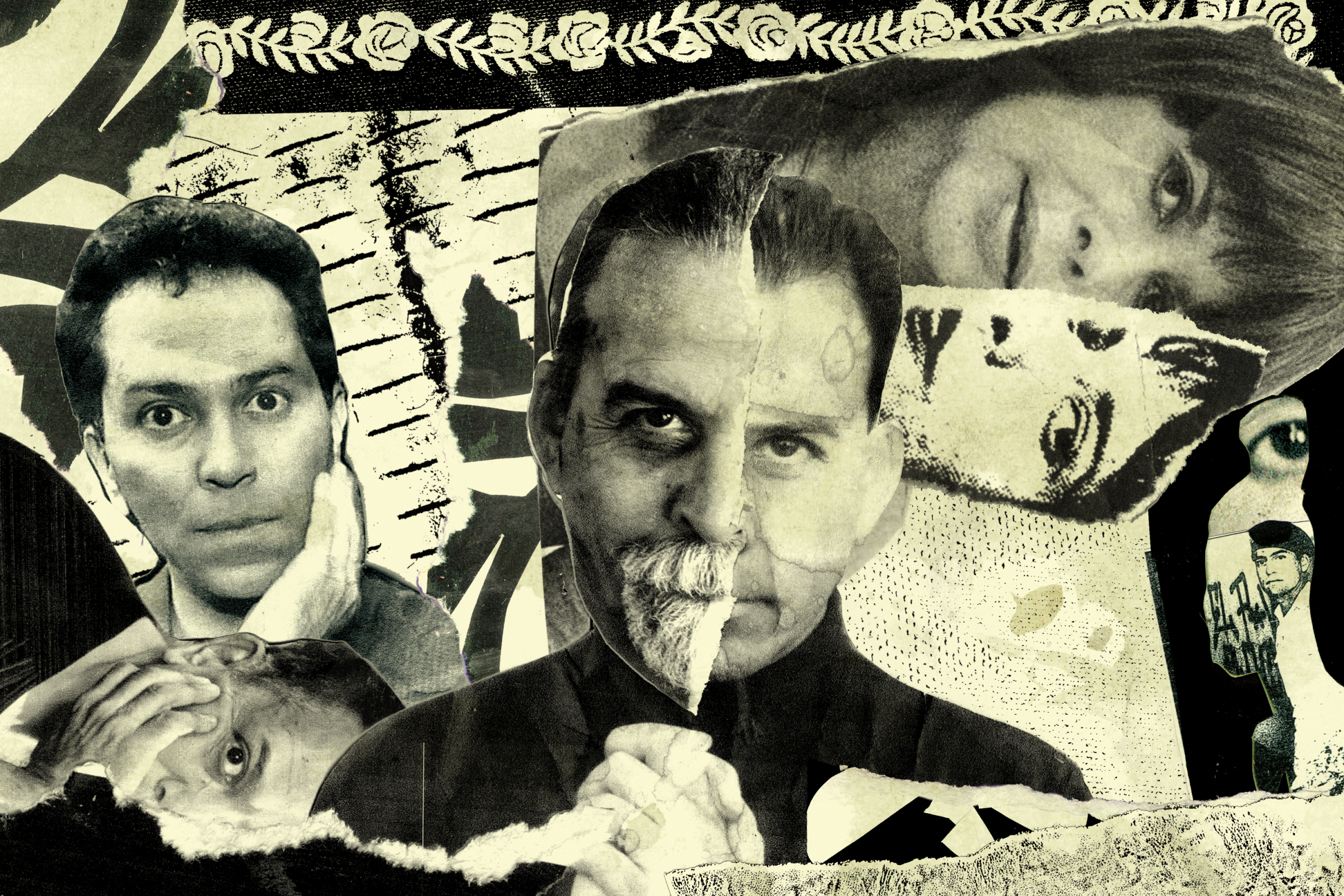
In April 1999, artists Harry Gamboa Jr. and Glugio Nicandro — better known as Gronk — sat down for an interview with a historian from the Smithsonian’s Archives of American Art to talk about the legacy of Asco, the East Los Angeles art group they helped found in the early 1970s. It was an amicable, rambling discussion, but parts of it now read like a harbinger of trouble ahead.
Asco was known for its glam looks and outrageous conceptual antics and for redefining what Chicano art could be. The members’ most legendary act: tagging the facade of the Los Angeles County Museum of Art with their names in 1972, then claiming the entire museum as a work of Chicano art.
In Gamboa’s famous photograph of that piece, “Spray Paint LACMA,” Asco member Patssi Valdez, in a red blouse and studded jeans, stands casually over the graffiti, which also bears the tag of the group’s fourth member, Willie Herrón III.
Asked by historian Jeffrey Rangel whether it was possible for Asco members to create an authoritative historical record of a group saturated in myth, Gamboa responded: “You’ll find that you can show everyone the same ink blot and we all see it a different way. And you know, some of us laugh; some of us find it to be a very beautiful picture; some of us get insulted and the rest of us will cry.”
That’s a poetic way of putting it. Perhaps the only thing Asco’s members will ever agree on is that they disagree.
This article was originally on a blog post platform and may be missing photos, graphics or links.
Those members are legendarily acrimonious. Their squabbles were the subject of a lengthy 2007 report in LA Weekly by Daniel Hernandez (now The Times’ food editor), who wrote that Asco “should be as famous for its interpersonal meltdowns as for its conceptual breakthroughs.” A 2011 story in the New York Times noted the group’s “rivalries and grudges.” As one L.A. artist I spoke with recently put it: “Asco invented the artist fight.”
But in recent months, the discord has reached a new crescendo. And it’s no light matter of art-monster gossip: The latest disputes could now affect how Asco’s work is displayed and how its story is ultimately told.
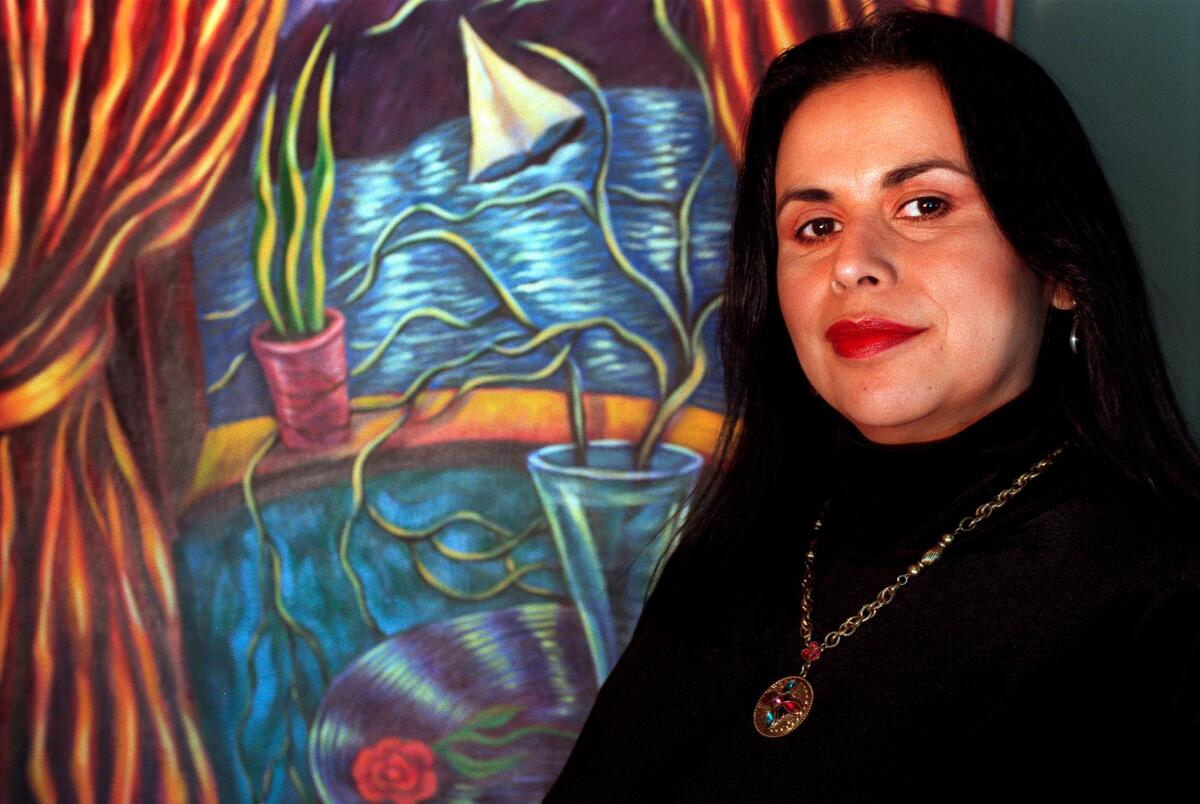
To get to the root of the conflict, consider a single image from the mid-1970s: “Limitations Beyond My Control,” which shows Valdez striking a balletic pose in a downtown tunnel with dancer Billy Starr and which is currently on view in a permanent collection exhibition at the Hammer Museum. The photo first surfaced there in the 2017 show “Radical Women: Latin American Art: 1960-85,” after which the museum acquired it. It appears under Valdez’s name, which Gamboa says violates his copyright, since he is the owner of the image. Valdez counters that Asco members historically shared their imagery and that he is credited as photographer. “Mail art, business cards — there was never an issue,” she says, “because it’s our work.”

Subscribers get exclusive access to this story
We’re offering L.A. Times subscribers special access to our best journalism. Thank you for your support.
Explore more Subscriber Exclusive content.
Moreover, Valdez notes that the piece is an archival poster from the ’70s that she previously exhibited under her name. Gamboa counters that it was not presented under her name alone. As a result of the conflict, the Hammer withdrew it from advertisements, although a large wall vinyl of “Limitations” still greets visitors to the show.
Other photographers took pictures of Asco’s flamboyant actions, but the vast majority and the most iconic images were taken by Gamboa, and it is he who has historically controlled dissemination of the group’s imagery (and presumably most of the sales). Since at least the 1980s, publications have generally attributed the work to Asco, while copyright has been held by Gamboa. This is how much of the work was credited in the catalog for its LACMA retrospective in 2011, “Asco: Elite of the Obscure, 1972-1987,” the most comprehensive source of information on the group. The catalog also included many images in which copyright is shared between Asco and Gamboa.
But in recent years, Gamboa has begun to demand that the photos be attributed solely to him, along with a description that reads, “from the Asco era.” “I would choose the locations,” he told The Times via telephone in March. “I would set up the camera. I would basically inform that we needed to get dressed up in costume. I would select who would be in the photograph.”
In an Instagram post that same month, Gamboa presented a different photograph of Valdez in the tunnel, one clearly taken during the same session, under the title, “Search and No Seizure.” The post included a statement that his process entails approving “a selected single image while rejecting the other images as being outtakes.” He also included a disclaimer asserting that “any participation in performance works does not imply co-authorship” and listed Valdez and Starr (born Guillermo Estrada) as “performers.”
(Gamboa, incidentally, dates the picture to 1974 on social media; Valdez has the date as 1975; LACMA’s catalog uses 1976; and a related essay by scholar David E. James attributes it to 1978. This gets at another indisputable fact about Asco: trying to verify even the most basic information is like trying to catch smoke with your hands.)
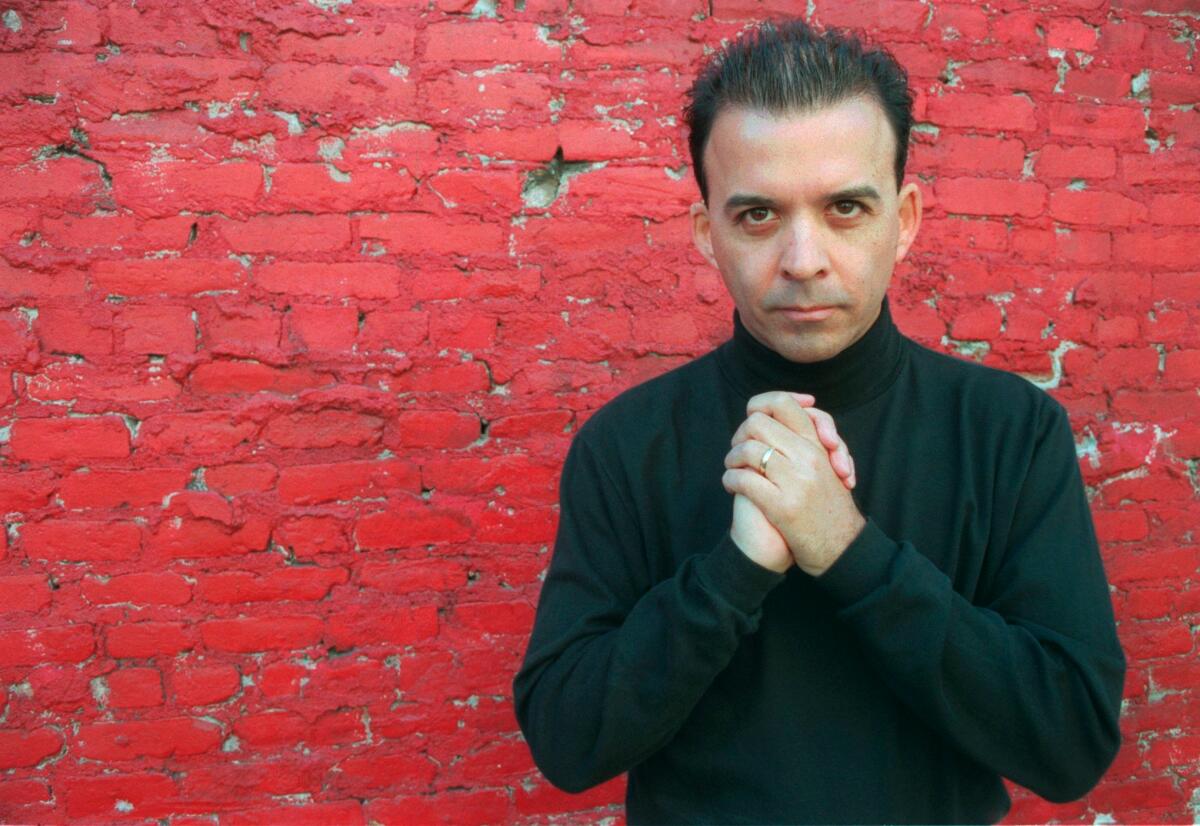
Valdez says the group’s work was not orchestrated by any one person; it was more like a collective collage. “There was no dictator,” she tells me. “I would do something and you would add to it and you would add to it and then it became visually interesting, and then Harry would set up and snap the picture. It was very spontaneous.” She insists that she was a contributor in a shared work, not a performer in someone else’s, “like a circus act.”
Gronk concurs. “I see them as Asco works,” he says. “To me, in a collaboration, you give up a little bit of yourself, and that to me is an important lesson that I learned from Asco. It’s not always going to be just yours.”
Mexican American art has come a long way since the movement of the 1970s. LACMA’s ‘Phantom Sightings’ traces its zigzag path.
Herrón declined to be interviewed for this story, stating briefly via text message: “I have no further comment on the labeling by the museums and publications not crediting Harry Gamboa Jr. as the photographer.” He did not respond to a follow-up question about the shift in attribution.
Gamboa says he is correcting what many museum catalogs, including LACMA’s, have gotten wrong for years. “The attribution to Asco was a curatorial decision,” he says, “a unilateral curatorial and scholarship decision without consulting me whatsoever.”
Rita Gonzalez, who co-curated the retrospective at LACMA, says the museum followed an established naming convention. By that time, Asco’s work had appeared at the List Visual Arts Center at the Massachusetts Institute of Technology in 1987, the Centre Pompidou in 2006 and a previous LACMA exhibition, “Phantom Sightings: Art After the Chicano Movement,” in 2008. Those exhibitions attributed the work to Asco and bore Gamboa’s copyright. Gamboa did not raise any concerns at the time of the retrospective, Gonzalez wrote via email. “The naming convention (for the labels) is typically defined or corroborated in loan forms signed by the lenders, as was the case in our presentation.”

Cecilia Fajardo-Hill, an independent curator who helped organize “Radical Women,” says Gamboa is rewriting history.
“This has gone too far,” she says. “As a curator, I’m getting cornered into situations where the only way to get the work of Asco is to accept that it’s not the work of Asco. It’s participating in an erasure of four people that worked democratically, collaboratively. Harry Gamboa had the camera. He had ideas. But he was one of four.”
Sign up for This Evening's Big Stories
Catch up on the day with the 7 biggest L.A. Times stories in your inbox every weekday evening.
You may occasionally receive promotional content from the Los Angeles Times.
Gamboa says it is Valdez and Fajardo-Hill (who is working on an exhibition of Valdez’s photography) who are profiting from his work and engaging in revisionism by listing Valdez as sole author of early Asco works. “This is a Patssi Valdez who was created through my male gaze in my 20s,” he says. This was iconography, he adds, that didn’t exist “unless it was in front of my camera. Patssi didn’t walk around looking like that.”
Valdez says the aesthetic she brought to the shoots was her own, cultivated through a long-running interest in fashion and film as well as formal training as a makeup artist. “If I was just this model or actress, do you think I’d be working for free all those hours?” she asks. “Where’s my pay? Do you think I’m a big dummy? That’s outrageous. I’m an artist.”
Gronk stands with Valdez: “She wasn’t a puppet. She was an individual who was creating, along with Harry, visual imagery.”

Who should control Asco’s legacy? And who should have the right to use and potentially profit from the work?
The answers to those questions may be impossible to determine. For decades, Asco’s images have been credited to Asco, with copyright to Gamboa, not by agreement but by circumstance.
When the four founding members got together as a group in the early 1970s, they were barely out of Garfield High School.
Herrón was drawing attention for innovative murals, including a 1972 work in City Terrace (which still stands today) whose design made it appear as if the surface of the building were crumbling. Valdez brought a glam aesthetic inspired partly by her interest in early silent film — she was a fan of Theda Bara. Gronk was already low-key infamous for staging a surreal work of theater titled “Caca-Roaches Have No Friends” that featured drag performer Cyclona (Robert Legorreta) biting a phallic water balloon placed between another performer’s legs. (Valdez, wearing plastic bags, inhabited the role of a giant mouth.) And there was Gamboa, a veteran of the school walkouts of 1968 and a witness to the 1970 Chicano Moratorium, a massive anti-Vietnam War rally marred by police violence — an event that inspired him to pursue photography.
Is it possible for an artist to begin a career in a determined anti-art mode, which spits out absurdist and confrontational gestures against the failures of bourgeois society, and then to switch successfully into a form that is steeped in conservative tradition?
Asco struck Los Angeles like an errant comet. Members shaved their eyebrows, staged a surreal dinner party in a traffic median and made an appearance in French director Agnès Varda‘s 1981 film “Mur Murs.” Their work was a combination of absurdist theatrics, gender-bending style (so many platform shoes!) and a take-no-prisoners approach that was as critical of Chicano exclusion as it was of Chicano dogma. Asco was Dada meets Ziggy Stardust in the streets of East Los Angeles — the artists’ bizarre and sublime actions recorded by Gamboa, who used Ektachrome slide film to give the imagery a cinematic cast.
“It is part of this fabricating of things that are more fabulous, more glamorous than they could have ever been, given the resources they had,” says C. Ondine Chavoya, who served as co-curator of the LACMA retrospective. “It was all about maximizing impact through the most meager and humble of means.”

Friction, it seems, was an essential ingredient. In a 1991 essay, Gamboa wrote that “individual and group appearances shifted according to indefinable moods, family problems, love interests, instant boredom, availability of materials, lack of sleep, and desire to maintain their personal identities in tact.” In that essay, which appeared in his collection “Urban Exile,” Gamboa hints at troubles beginning as early as 1974.
Examining some of the group’s now iconic pieces — “Spray Paint LACMA” and “Decoy Gang War Victim,” a haunting 1974 image that shows Gronk lying in the middle of a street at night, surrounded by flares — it can be easy to forget that the artists were in their early 20s when they made these works. Which explains why they were likely less preoccupied with questions of attribution than in what they were going to do next.
Asco was never the sort to take votes or adhere to a manifesto like Los Four, another prominent Chicano group of the era. By most accounts — including oral histories, scholarly essays and nearly two dozen interviews conducted by The Times for this story — its artistic process in the early days was freewheeling. Ideas were brainstormed in either Valdez’s or Herrón’s garage, images were generated and then transformed into objects such as photographs and mail art. LACMA’s catalog even includes a matchbook, bearing an image of Gamboa and Valdez, used to advertise the Montebello hair salon owned by Valdez’s mother.
Collaborators came in and out of the group, including Humberto Sandoval, who participated in many key works. As the years passed, the lineup evolved. In 1982, Valdez departed to attend art school and Herrón to pursue music. Gronk and Gamboa remained, working with a shifting group of artists during a period some describe as “Asco II.” (For the purposes of this story, I’ve focused exclusively on Asco I, 1972-82).
Asco’s final happening took place in spring 1987, after which the group was over for good. In a letter typewritten in red ink, Gamboa expressed his anger at seven members of Asco II (including Gronk) over unprofessional behavior. (It wasn’t permanent. On the list are at least two artists who have remained friends with Gamboa, as well as muralist Barbara Carrasco, whom he ultimately married.)
The events and emotions of the Chicano Moratorium still reverberate in L.A.’s Latino community 50 years later.
For a time, Asco’s visibility faded. Gamboa went on to other photographic projects (among them a portrait series on Chicano men), as well as a teaching career (he is currently on the faculty at the California Institute of the Arts). Valdez turned her attention to painting; Gronk became a painter and a set designer; Herrón, a musician and mural restorer.
In the 21st century, however, Asco came roaring back — most notably through the LACMA retrospective, which generated a front page cover in Artforum and the feature in the New York Times. (At the time, I profiled the group for Public Radio International, interviewing the four separately because they would not come together as a group.) The show lighted a fire, making Asco popular with a younger generation of Latino conceptual artists hungry for role models who weren’t white Western canon. It also led museums to acquire the work.
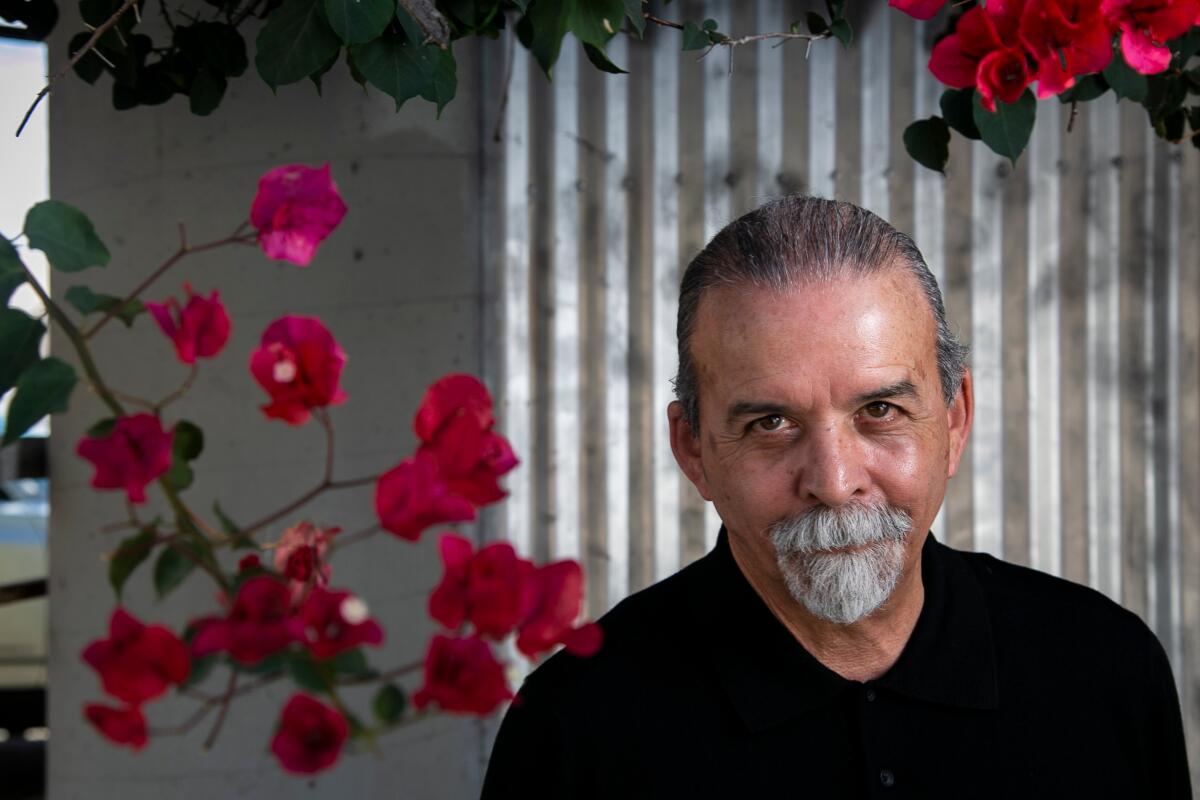
The LACMA show also lighted a fire under long simmering conflicts. Isolated skirmishes under shifting alliances coalesced into trench warfare. At stake, certainly, is money — although any gains are likely modest; while Asco’s artists may be intellectual darlings, they are not necessarily art market stars. More significant, it seems, is control, especially at a time when the artists, now in their 70s, are in legacy-building mode.
Gamboa, who has perhaps been the most devoted to tending the Asco flame, says his intentions are “to make it very clear to institutions that if they want to use the work, they should double-check with me.” Valdez, who was central to a lot of Asco’s early imagery, says she feels “exploited” by an arrangement in which her image is distributed with zero say. “That’s 10 years of my work,” she says, “and for someone to say it’s just theirs is appalling.”
Gronk says he recognizes the skill Gamboa brought to the photography. “Harry did create the iconic images,” he says. “If you look at his camera work, it’s pristine in many ways.” But these emerged as the result of group collaboration. “I’m not claiming to invent Asco,” says Gronk. “But I was a participant in that group, and I contributed a lot to it.”
Asco’s work thrived when no one was looking. Now that the group is being hailed in high art circles, personal animosities threaten the future of the work itself. Which means the legacy of artistic rebels could now hang on the letter of the law.

Under U.S. copyright law, a joint work is created by multiple authors who intend to merge their contributions into a unitary piece of art.
Valdez and Gronk say they’ve always seen Asco’s work as belonging to the group. Gamboa says that that was never the case. “It was never intended that this authorship is shared with everyone,” he says. “It’s my image, through my eye and my decision to snap the picture at the critical moment.”
Many of Asco’s images were conceptual in nature, staged for the camera, and Gamboa himself appeared in many of them. The group, for example, created faux film stills called “No Movies” that predate Cindy Sherman’s “Untitled Film Stills” by several years. These include the images of Valdez in the tunnel as well as “Decoy Gang War Victim,” the picture that ultimately graced the cover of Artforum.
Was it Gamboa’s intent, back in the ’70s, to be a co-creator of a larger group work? Was he documenting a performance that was external to him? Was he directing the work as auteur? The answers to these questions would affect the nature of authorship and copyright. And the problem with that is that just about every detail of Asco’s work has been stewing in lore built up over half a century.
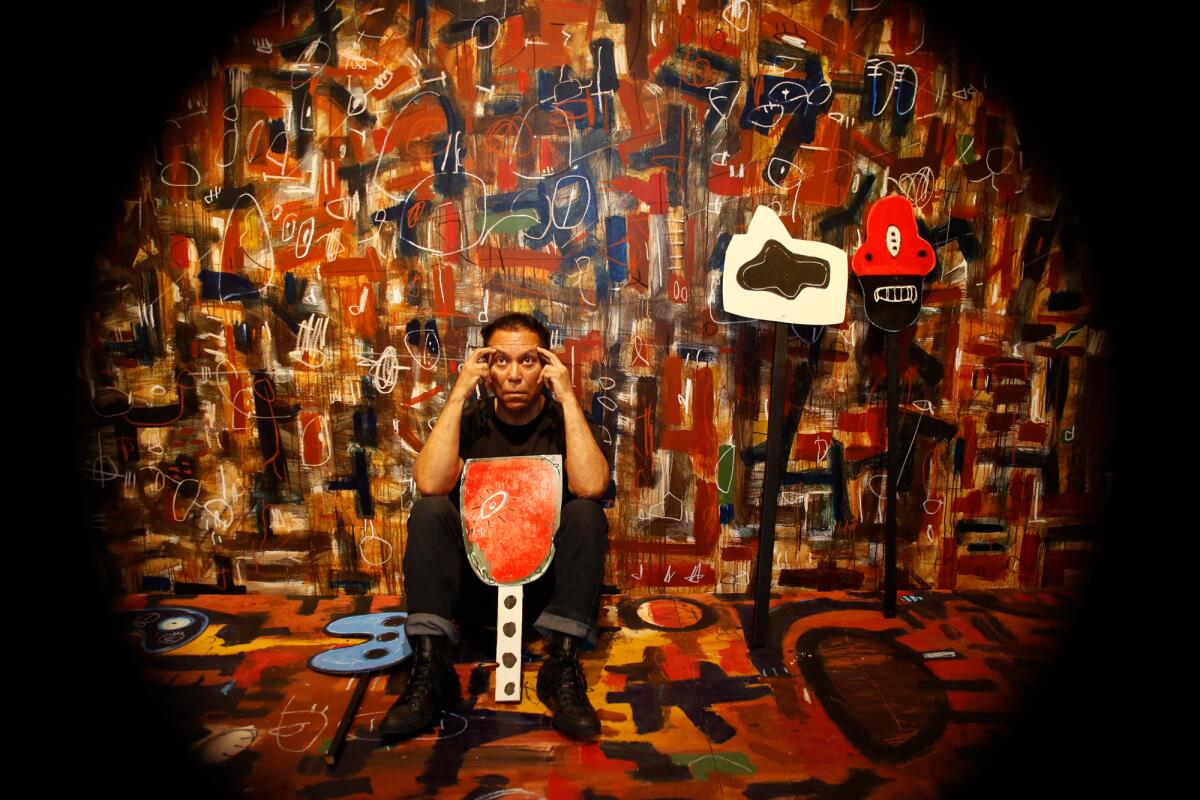
THE FOUR YOUNG Chicanos would meet daily in the International House of Pancakes on Atlantic Boulevard, looking a little conspicuous for East Los Angeles in 1971.
Gronk and Valdez say images often came before the narratives — an idea echoed by Herrón in an interview I conducted with him in 2011. “A lot of artists, it’s difficult for them to work that way,” he told me then. “They really have to sit down and think about what they’re doing. ... We did the opposite. We did it first and then we figured out, what the heck did we just do?”
That narrative slipperiness, and the mythology that’s developed around it, doesn’t take away from larger truths Asco sought very deliberately to elucidate about inequality, police brutality and the lockout of Chicanos from mainstream institutions. But to try to ascertain how individual works were conceived is to fall down a rabbit hole of he-said/she-said, since oftentimes, the only people in the room were the four original members.
On “Decoy Gang War Victim,” which was essentially a faux crime scene, Gamboa says he “conducted research into the Mercury-vapor lamps that emitted a certain blueish glow,” chose the site and then asked Gronk to pose. Gronk’s version of events is completely different. “I laugh at that because none of that happened,” he says. The idea, he says, emerged spontaneously after he spied the flares on the street as they drove past. “I popped out of the car, ran over there, got the shot and then we were gone.”
Sandoval, who was present for key works and remembers his time with Asco very fondly, was loathe to commit to any particular version of events. He saw Gamboa and Gronk as the group’s intellectual architects, but adds that it has all become blurry with time: “Everybody was doing something. Patssi was doing something. I was doing something. And nobody was signing off on releases.”
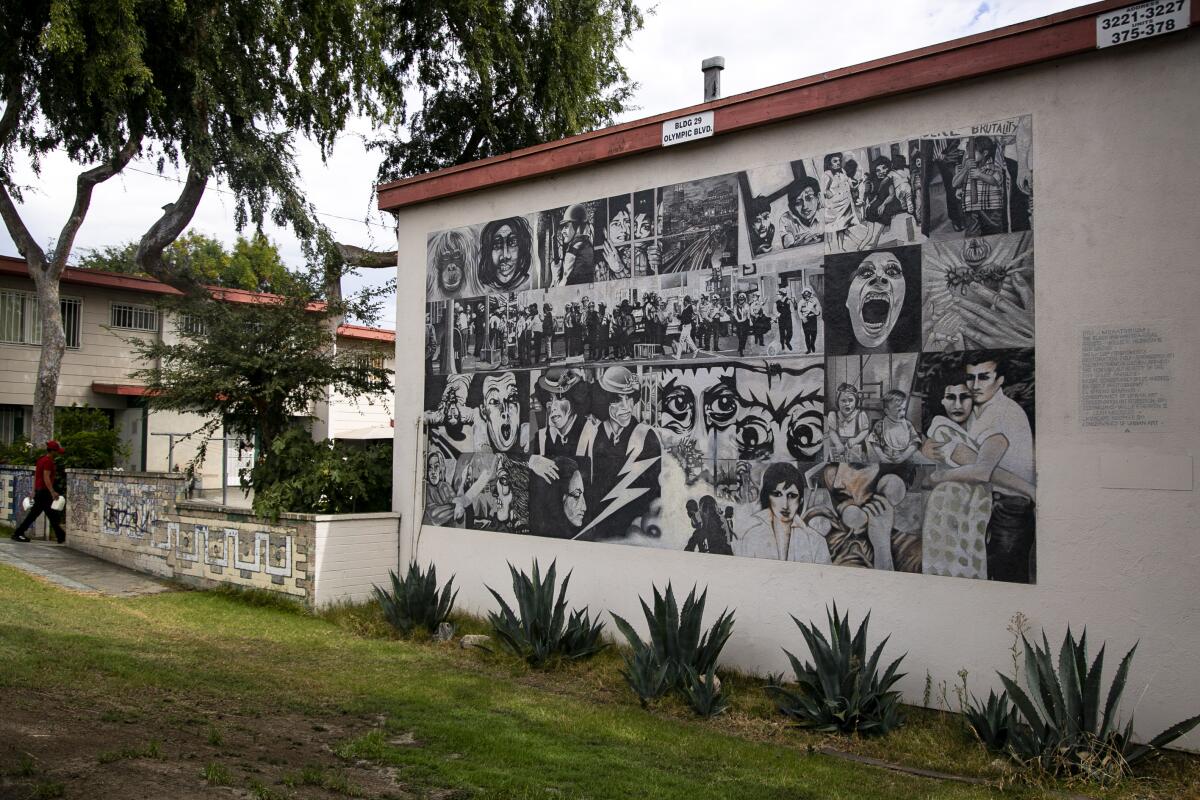
Three intellectual property attorneys I consulted with for this story said Asco presents a challenging case.
Generally, copyright goes to a photographer or videographer, says M.J. Bogatin, a partner at Bogatin, Corman & Gold in Oakland who is also an attorney for the legal-services nonprofit California Lawyers for the Arts. But “if the photographer has admitted somewhere that this was done with mutual intention to belong to the group, then the group might well prevail on a claim that they all share the copyright.” In that case, members of the group could be entitled to make derivative works (such as Valdez’s poster at the Hammer). The group would also share in profits from any sales.
Ultimately, however, the onus to prove mutual intention would rest with Valdez, Gronk and Herrón. Gamboa states that he did not set out to create a joint work. The other members of Asco, to prove their case in court, would need to present evidence that Gamboa once felt differently.
Margit Livingston, a professor at DePaul University in Chicago who focuses on copyright law, says the photography could be seen as a way of copyrighting a larger performance: “So you’d say the photographer in that situation is operating as the agent of the group in fixing the work into a tangible medium so it can be copyrighted.” But that would depend on the nature of the performance and whether it was copyrightable, or whether the photographer served as documentarian or director.
Tilting goblets. Tipping pedestals. And floors that seem to roil and whirl.
Complicating things is the way the photography was employed in the ’70s. Both Gronk and Valdez say Gamboa often supplied them with slides or negatives to create other works, such as mail art. This, says Amelia Brankov, chair of the Art Law Committee of the New York City Bar Assn., could be interpreted as an “implied license” by the photographer, setting precedent for their future use.
Valdez and Gronk say Gamboa gave them each a set of slides of Asco’s work after the group’s dissolution; Gamboa says they were lent and never returned — noting that to give someone slides doesn’t imply that you are giving them copyright. He also says he registered the images for copyright, but he can’t recall when.
Searches of two copyright databases did not turn up registrations under either Gamboa or Asco. If they were registered under another name, Gamboa says he doesn’t recall. “You’re asking a question,” he says, “from half a century ago.” (Digital searches could be incomplete because registrations were maintained in card catalogs in the 1970s.) Notably, Gamboa has never taken legal action to defend his copyright claim.

Without written agreements — Asco has never had one — or a legal paper trail, sorting out questions of authorship would be labyrinthine. “Documents disappear, memories fade and people misremember things,” says Brankov. “And that’s why you have statutes of limitation. ... And courts are so bogged down that a judge would probably say: ‘Try to sort it out.’”
All the attorneys I spoke with urged mediation. Otherwise, says Bogatin, “it will be a lose-lose-lose-lose proposition.” California Lawyers for the Arts, he notes, offers such a service. Valdez and Gronk said they are open to the idea; Gamboa, however, is not.

Over the last few years, Asco’s conflicts have played out relatively privately. When an Asco work that is not of Gamboa’s provenance pops up in a museum, he will reach out to curators to assert his copyright claim. (I have been copied on some of these missives.) This happened in 2017, when Valdez used an Asco image of herself in a two-artist show at the Millard Sheets Art Center in Pomona, and again last year, in a group show devoted to the Virgin of Guadalupe at the Museum of Latin American Art in Long Beach. Like the Hammer impasse, these disputes have been mediated by curators. Gamboa, for reasons he declines to discuss, will not reach out to Valdez directly.
But the conflict has begun to spill out onto social media, and some art world insiders have noticed the fluctuating attributions. The Smithsonian Institution and the Whitney Museum of American Art both credit Asco for the work, while noting that Gamboa holds copyright. The Getty Museum gives sole authorship to Gamboa, but copyright to Gamboa and Asco, and the Museum of Contemporary Art Los Angeles, which currently has three Asco photographs on display, gives attribution and copyright to Gamboa, although Asco and its members are mentioned in the wall text.
Photographer Louis Jacinto, who became acquainted with Asco back in the ‘70s, recently posted a selfie at MOCA to Facebook with the caption: “Mislabeled photos at MOCA Los Angeles. Should read Asco photographs.” In an emailed statement, a representative for MOCA stated, “In light of ever-evolving discussions around best practices for attribution of collective artworks, and with ongoing discourse and research, the museum is taking the opportunity to review the best way to honor the collaborative structure of Asco in artwork attribution.”
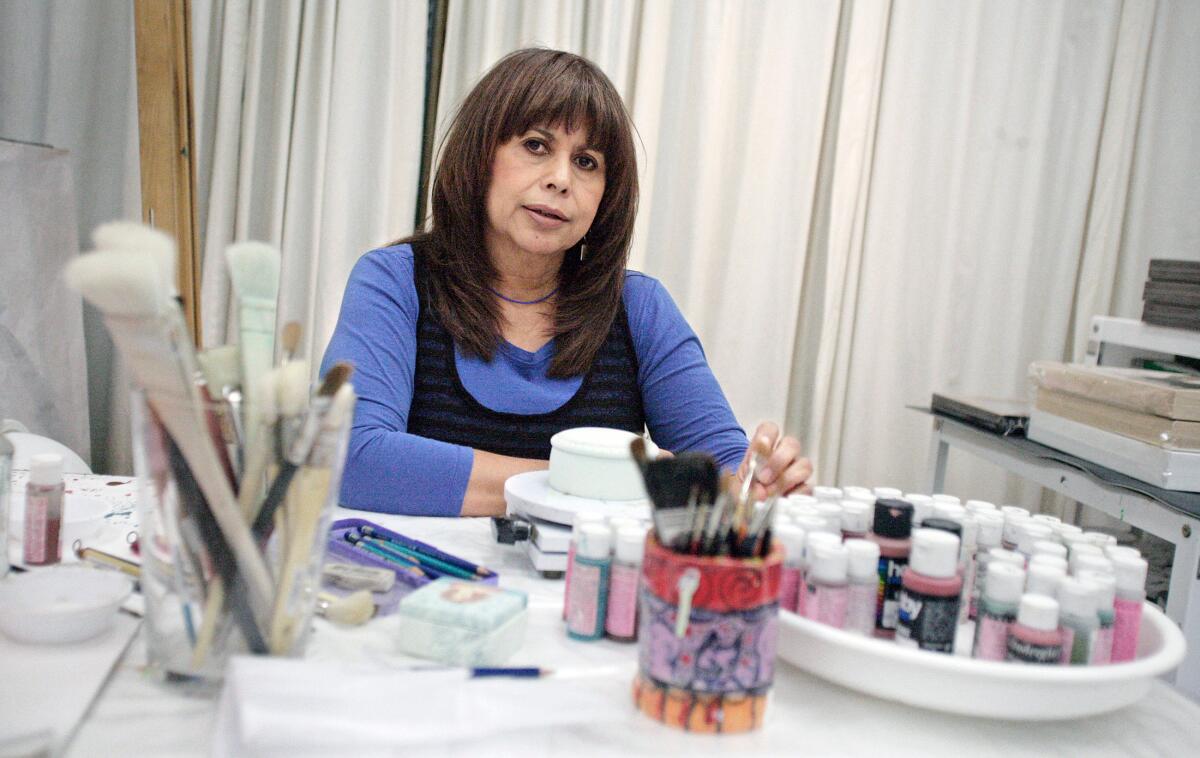
Artist and scholar Amalia Mesa-Bains, who is at work on a book about Valdez for UCLA’s Chicano Studies Research Center, says she believes that Asco’s works were collectively made and that conflicts over credit could make museums “hesitate in acquiring important works because they live and die by provenance.”
She says the conflict has other repercussions. “What makes me really sad is that the Chicano movement has a history of collaborative groups,” she says — such as the Royal Chicano Air Force out of Sacramento. “That was so important. ... So when you end up years later tearing it apart in this way, it doesn’t just hurt the people involved, it hurts the values of our movement.”
The performance begins with coffee.
In April, I attended the opening night party of a pop-up exhibition in the Los Angeles Arts District that displayed art by Asco members alongside the work of younger Latinx artists. As a presenter hailed “collaboration” from a small stage, Gamboa stood in the gallery while Valdez lingered just beyond the doorway; Gronk and Herrón were nowhere to be seen. The Asco works on view were credited solely to Gamboa.
It made me recall an essay Gamboa wrote in 1994 about the trouble with trying to present a definitive history of Asco. “The tangible evidence that remains of Asco is supported by hearsay and conflicting memories of plausible events,” he wrote then. “The works of Asco were often created in transitory or easily degradable materials that crumble at the slightest prodding and fade quickly upon exposure to any glimmer of hope.”
Here’s hoping that’s not the case.
The biggest entertainment stories
Get our big stories about Hollywood, film, television, music, arts, culture and more right in your inbox as soon as they publish.
You may occasionally receive promotional content from the Los Angeles Times.